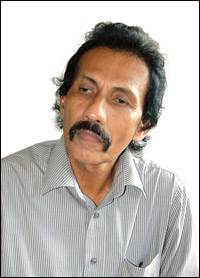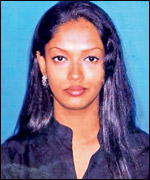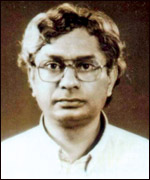Anticipating a new musical era
Aravinda
Hettiarachchi meets Visual and Performing Arts University’s Western
Music Department Founder B R Dassanayake
There is no language more powerful than the language of music. It is
distinct, universal and exemplified in culture. Music reaches out to
individuals crossing cultural and linguistic barriers. It unites us all
as it envelopes its enchanting beauty and rhythm.
|

B. R. Dassanayake founded the Western Music Department of Visual
and Performing Arts University. Picture by Sumanachandra
Ariyawansa |
Government Collage of Music or the Government Collage of Fine Arts
was initiated in 1949 with one aesthetic subject, Painting. The Visual
and Performing Arts University has come a long way. It shifted to Albert
Crescent in 1952 with two more subjects: North Indian Classical Music
and Dancing.
The college gained recognition as a University in 1974. North Indian
Classical Music and Local Folk Music were taught. Dassanayake’s entered
the university in 1977.
“Only a few Eastern musical instruments of North Indian Classical
Music were taught at the time.
“It was limited, but the college produced several local artistes who
had excelled in eastern art. This is not enough. We need to deal with
various traditions and artistes of international standards. We need to
work on different musical instruments and styles. Many instrumental
artistes from radio and television made requests because they lacked
skills.”
He recalled adding that the eastern music centred extremist minds and
the institutional hierarchy did not allow western music to prevail
within the university. “Students and intellectuals demanded the subject.
It was an ongoing tug-of-war but in 1974 Western music was accepted as a
subject limited to examination papers. During my stint as the section
head I wanted to bring the genre as a secondary subject. We began with
the piano, classical guitar and violin. It expanded trough the years and
more students are learning the effective and refine the style of the art
today,” he emphasized.
The department now teaches students to handle the western violin,
flute, saxophone, clarinet, cello, viola, classical and flamenco guitar.
Vocal training is also a part of the subject.
Bhathkande and Shanthi Nikethan too taught North Indian Classical
Music in the beginning. Yet in the 1940s, Western musical instruments
and their counterparts were required for the thriving Indian film
industry.
|

Sakya Wanamal teaches the cello. She is one of the best Sri
Lankan cellists |

Vajira Nanayakakara teaches theory. He is one architect of music
courses in the National Education Institute |

Ananda Premasiri teaches saxophone and clarinet. He is a member
of the Lankan Symphony Orchestra and has performed in several
countries |

Amaranath Ranathunge teaches classical and flamenco guitar. He
is the first to make a syllabus to a four-year degree course in
South Asia for these instruments |

Lakshman Joseph de Seram teaches violin. He has conducted many
symphonies, with several awards for film music and plays to his
credit |
“India is influenced by Western music in an indirect manner. They
thought about the purity of North Indian Classical music in the past.
They too added only the theory part of western music into their
university syllabi. North Indian Classical music had preserved its own
course. Western music had only influenced Indian cinema and performance
art,” noted Dassanayake.
Starting from North Indian classical music Dassanayake says that he
drew inspiration form Quintas Jayakodi. The Catholic artiste’s musical
creations were rich with the essence of North Indian and Western music.
“I realized that both are vital to the local music field. I wanted to
learn and understand these two cultures in a broader level. I have
worked for the SLBC where they used these instruments,” he explained how
the idea of introducing the subject to the university took shape.
Dassanayake says that he had a prototype of the previous system used to
teach the North Indian Classical music in the university.
|
Trainings |
* Vocals
* Western violin
* Flute
*Saxophone
* Clarinet
*Cello
*Viola
*Classical guitar
* guitar |
“I called some people who studied Western music on their own. Most of
them have reached the standers of professionals. Some of them had top
grades from highly recommended examinations. Others are geniuses sans
formal certificates. They joined in as western music teachers. Their
students gained more than 80 percent at top level international degree
exams, mostly conducted by the Royal and Trinity Collages in Europe.”
Foreign examiners linked with international musical projects highly
appreciated the educational techniques and quality, Dassanayake noted.
Their next challenge is in bringing out the first batch of degree
holders. They also hope to introduce more western musical instruments to
their collection. Western drums will be the first to make appearance
next year.
“We hope our students will make it to the international level. We
wish to build a generation of teachers, music composers and individuals
who embody the passion to experiment in music and take it to a new
level. Our target is the foreign market and make a name for the country
in the global arena,” he concluded. |



